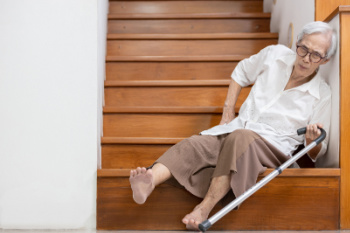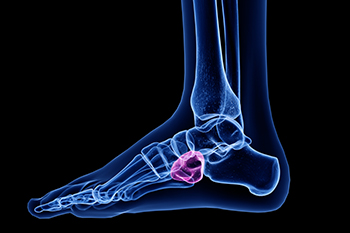
Falls pose a significant threat to the health of seniors, often leading to serious injuries such as fractures or head trauma. The risk of falling increases as balance and coordination naturally decline with age, making it harder for older adults to move safely. In addition to physical changes, issues like poor vision or medication side effects can contribute to the risk of falls. That is why it is vital for seniors to have regular eye exams to ensure their vision is sharp and clear. Properly correcting vision can significantly reduce the chances of missteps or accidents. Maintaining good balance through exercises like tai chi or strength training can also improve stability and reduce the risk of falls. In the home, removing clutter and installing safety features such as grab bars can further enhance safety. Falling can seriously impact foot health. If this has happened to you, it is suggested that you consult a podiatrist who can offer effective relief and treatment tips, and guide you on additional fall prevention techniques.
Preventing falls among the elderly is very important. If you are older and have fallen or fear that you are prone to falling, consult with Paul A. Santangelo, DPM from Illinois. Our doctor will assess your condition and provide you with quality advice and care.
Every 11 seconds, an elderly American is being treated in an emergency room for a fall related injury. Falls are the leading cause of head and hip injuries for those 65 and older. Due to decreases in strength, balance, senses, and lack of awareness, elderly persons are very susceptible to falling. Thankfully, there are a number of things older persons can do to prevent falls.
How to Prevent Falls
Some effective methods that older persons can do to prevent falls include:
- Enrolling in strength and balance exercise program to increase balance and strength
- Periodically having your sight and hearing checked
- Discuss any medications you have with a doctor to see if it increases the risk of falling
- Clearing the house of falling hazards and installing devices like grab bars and railings
- Utilizing a walker or cane
- Wearing shoes that provide good support and cushioning
- Talking to family members about falling and increasing awareness
Falling can be a traumatic and embarrassing experience for elderly persons; this can make them less willing to leave the house, and less willing to talk to someone about their fears of falling. Doing such things, however, will increase the likelihood of tripping or losing one’s balance. Knowing the causes of falling and how to prevent them is the best way to mitigate the risk of serious injury.
If you have any questions, please feel free to contact our offices located in Niles and Rockford, IL . We offer the newest diagnostic and treatment technologies for all your foot care needs.

Cuboid syndrome is a foot condition that involves the misalignment or dysfunction of the cuboid bone, which is located on the outer side of the midfoot. This misalignment can lead to pain and discomfort, particularly when walking or running. The causes of cuboid syndrome are varied and often linked to midtarsal instability, where the bones in the midfoot lose their normal alignment. Excessive body weight can also contribute, as it puts added pressure on the foot and increases the risk of injury. Poor footwear, such as shoes that do not provide adequate support, can worsen the condition by failing to properly stabilize the foot. Training on uneven surfaces or engaging in high-impact activities without proper foot care can further increase the risk of cuboid dysfunction. Additionally, a previous foot or ankle sprain may leave the foot vulnerable to developing cuboid syndrome, making proper recovery and prevention measures essential for foot health. If you have pain in this part of your foot, it is suggested that you contact a podiatrist who can provide a proper diagnosis and treatment.
Cuboid syndrome, also known as cuboid subluxation, occurs when the joints and ligaments near the cuboid bone in the foot become torn. If you have cuboid syndrome, consult with Paul A. Santangelo, DPM from Illinois. Our doctor will assess your condition and provide you with quality foot and ankle treatment.
Cuboid syndrome is a common cause of lateral foot pain, which is pain on the outside of the foot. The condition may happen suddenly due to an ankle sprain, or it may develop slowly overtime from repetitive tension through the bone and surrounding structures.
Causes
The most common causes of cuboid syndrome include:
- Injury – The most common cause of this ailment is an ankle sprain.
- Repetitive Strain – Tension placed through the peroneus longus muscle from repetitive activities such as jumping and running may cause excessive traction on the bone causing it to sublux.
- Altered Foot Biomechanics – Most people suffering from cuboid subluxation have flat feet.
Symptoms
A common symptom of cuboid syndrome is pain along the outside of the foot which can be felt in the ankle and toes. This pain may create walking difficulties and may cause those with the condition to walk with a limp.
Diagnosis
Diagnosis of cuboid syndrome is often difficult, and it is often misdiagnosed. X-rays, MRIs and CT scans often fail to properly show the cuboid subluxation. Although there isn’t a specific test used to diagnose cuboid syndrome, your podiatrist will usually check if pain is felt while pressing firmly on the cuboid bone of your foot.
Treatment
Just as the range of causes varies widely, so do treatments. Some more common treatments are ice therapy, rest, exercise, taping, and orthotics.
If you have any questions, please feel free to contact our offices located in Niles and Rockford, IL . We offer the newest diagnostic and treatment technologies for all your foot care needs.

Chronic tophaceous gout is a severe stage of gout that impacts the feet, toes, and ankles, causing significant discomfort and potential joint damage. Chronic tophaceous gout occurs when uric acid levels remain consistently high, leading to the formation of tophi, which are hard, chalky deposits of urate crystals that form under the skin around joints and tissues. These tophi often appear as painful lumps that can contribute to swelling, redness, warmth, and tenderness in the affected areas, commonly the big toe or ankle. Left untreated, chronic tophaceous gout can lead to cartilage damage, bone erosion, and a decreased range of motion in the feet and ankles. Kidney issues, diabetes, or consuming a diet high in purine-rich foods can increase the likelihood of developing tophaceous gout. A podiatrist can identify tophi, offer guidance on lifestyle adjustments, and recommend treatment to control uric acid levels and minimize joint damage. If you are suffering from gout in your feet, it is suggested that you schedule an appointment with a podiatrist for an exam and treatment options.
Gout is a foot condition that requires certain treatment and care. If you are seeking treatment, contact Paul A. Santangelo, DPM from Illinois. Our doctor will treat your foot and ankle needs.
What Is Gout?
Gout is a type of arthritis caused by a buildup of uric acid in the bloodstream. It often develops in the foot, especially the big toe area, although it can manifest in other parts of the body as well. Gout can make walking and standing very painful and is especially common in diabetics and the obese.
People typically get gout because of a poor diet. Genetic predisposition is also a factor. The children of parents who have had gout frequently have a chance of developing it themselves.
Gout can easily be identified by redness and inflammation of the big toe and the surrounding areas of the foot. Other symptoms include extreme fatigue, joint pain, and running high fevers. Sometimes corticosteroid drugs can be prescribed to treat gout, but the best way to combat this disease is to get more exercise and eat a better diet.
If you have any questions please feel free to contact our offices located in Niles and Rockford, IL . We offer the newest diagnostic and treatment technologies for all your foot and ankle needs.

